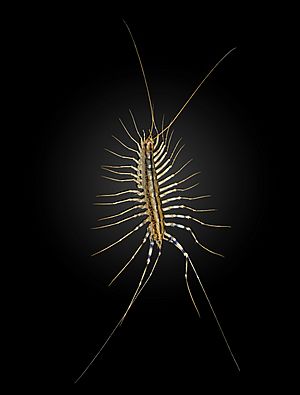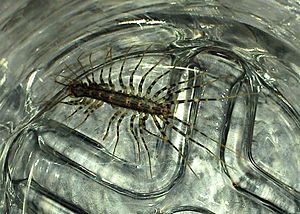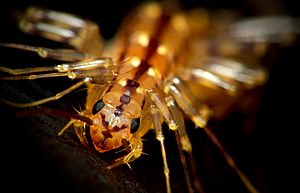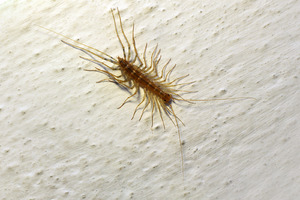House centipede facts for kids
Quick facts for kids House centipede |
|
|---|---|
 |
|
| Scientific classification | |
| Kingdom: | |
| Phylum: | |
| Class: | |
| Order: |
Scutigeromorpha
|
| Family: |
Scutigeridae
|
| Genus: |
Scutigera
|
| Species: |
S. coleoptrata
|
| Binomial name | |
| Scutigera coleoptrata |
|
Scutigera coleoptrata, more commonly known as House centipedes, are yellowish grey centipedes having up to 15 pairs of legs.
The species are found all across the world and live in human apartments or houses. The house centipede is an insectivore; it kills and eats arachnids and insects. They were first discovered around 1758. These centipedes are harmless to humans, although humans may be startled by them.
Contents
Morphology
The body of an adult Scutigera coleoptrata is 25 to 35 mm (0.98 to 1.38 in) in length. Up to 15 pairs of long legs are attached to the rigid body. Together with the antennae they give the centipede an appearance of being 75 to 100 mm (3 to 4 in) in length. The delicate legs enable it to reach surprising speeds of up to 0.4 meters per second (1.3 ft/s) running across floors, up walls and along ceilings. Its body is yellowish-grey and has three dark dorsal stripes running down its length; the legs also have dark stripes. S. coleoptrata has developed automimicry in that its tail-like hind legs present the appearance of antennae. When the centipede is at rest, it is not easy to tell its cranial end from its caudal end.
Unlike most other centipedes, house centipedes and their close relatives have well-developed faceted eyes.
Reproduction and development
House centipedes lay their eggs in spring. In a laboratory observation of 24 house centipedes, an average of 63 and a maximum of 151 eggs were laid. As with many other arthropods, the larvae look like miniature versions of the adult, albeit with fewer legs. Young centipedes have four pairs of legs when they are hatched. They gain a new pair with the first molting, and two pairs with each of their five subsequent moltings. Adults with 15 pairs of legs retain that number through three more molting stages (sequence 4-5-7-9-11-13-15-15-15-15 pairs).
House centipedes live anywhere from three to seven years, depending on the environment. They can start breeding in their third year. To begin mating, the male and female circle around each other. They initiate contact with their antennae. The male deposits his sperm on the ground and the female then uses it to fertilize her eggs.
Behavior and ecology
House centipedes feed on spiders, bed bugs, termites, cockroaches, silverfish, ants, and other household arthropods. They administer venom through forcipules. These are not part of their mandibles, so strictly speaking they sting rather than bite. They are mostly nocturnal hunters. Despite their developed eyes, they seem to rely mostly on their antennae when hunting. Their antennae are sensitive to both smells and tactile information. They use both their mandibles and their legs for holding prey. This way they can deal with several small insects at the same time. To capture prey they either jump onto it or use their legs in a technique described as "lassoing". Using their legs to beat prey has also been described. Like other centipedes they can stridulate.
In a feeding study, S. coleoptrata showed the ability to distinguish between possible prey, avoiding dangerous insects. They also adapted their feeding pattern to the type of hazard the prey might pose to them. For wasps, they retreat after applying the venom to give it time to take effect. When the centipede is in danger of becoming prey itself, it can detach any legs that have become trapped. House centipedes have been observed to groom their legs by curling around and grooming them with their forcipules.
In 1902, C. L. Marlatt, an entomologist with the United States Department of Agriculture, wrote a brief description of the house centipede:
It may often be seen darting across floors with very great speed, occasionally stopping suddenly and remaining absolutely motionless, presently to resume its rapid movements, often darting directly at inmates of the house, particularly women, evidently with a desire to conceal itself beneath their dresses, and thus creating much consternation.
Habitat
Outdoors, house centipedes prefer to live in cool, damp places. Centipede respiratory systems do not provide any mechanism for shutting the spiracles, and that is why they need an environment that protects them from dehydration and excessive cold. Most live outside, primarily under large rocks, piles of wood, and especially in compost piles. Within the home, these centipedes are found in almost any part of the house. Most commonly they are encountered in basements, bathrooms, and lavatories, which tend to be humid, but they can also be found in drier places like offices, bedrooms and dining rooms. The greatest likelihood of encountering them is in spring, when they come out because the weather gets warmer, and in autumn/fall, when the cooling weather forces them to find shelter in human habitats.
Distribution
S. coleoptrata is indigenous to the Mediterranean region, but it has spread through much of Europe, Asia, North America and South America. It is thought to have first been introduced to the Americas in Mexico and Guatemala and now it reaches north into Canada and south to Argentina.
In the United States, it spread north from the southern states, reaching Pennsylvania in 1849, New York in 1885, and Massachusetts and Connecticut in about 1890. In 2009, its distribution extended from Virginia in the east to the coast of California in the west.
In 2011 it was sighted in Chile, in the Metropolitan and Los Lagos regions.
In South Africa, they have been found in the Western Cape, in and around Cape Town (sightings have been reported in Pinelands; Vredehoek, Mowbray, Edgemead, Green Point, Zonnebloem, Woodstock; Stellenbosch and Gordon's Bay) and also in KwaZulu-Natal, in the city of Pietermaritzburg. They are also found around the Garden Route, including Oudtshoorn, Mossel Bay, George and Knysna, and in Bloemfontein in the Free State.
In 2013 they were recorded in Lichinga, Mozambique, and in 2017 in Pemba and at Lujeri Tea Estate, Mulanje, Southern Malawi.
They have been found in eastern and southern Australia, from Perth to Adelaide, South Australia, to Sydney, New South Wales and in Tasmania. Other countries they have been found in include New Zealand, Japan and South Korea.
It is relatively rare in South and Southeast Asia.
Biological details
The faceted eyes of S. coleoptrata are sensitive to daylight and very sensitive to ultraviolet light. They were shown to be able to visually distinguish between different mutations of Drosophila melanogaster. How this ability fits with its nocturnal lifestyle and underground natural habitat is still under study. They do not instantly change direction when light is suddenly shone at them, but will retreat to a darker hiding spot.
Some of the plates covering the body segments fused and became smaller during the evolution to the current state of S. coleoptrata. The resulting mismatch between body segments and dorsal plates (tergites) is the cause for this centipede's rigid body.
| Tergite | 1 | 2 | 3 | 4 | 5 | 6 | 7 | 8 | 9 | 10 | 11 |
|---|---|---|---|---|---|---|---|---|---|---|---|
| Segments | 1 | 2 | 3, 4 | 5, 6 | 7, 8, 9 | 10, 11 | 12, 13 | 14, 15 | 16 | 17 | 18 (telson) |
| Leg pairs | Forcipules | 1 | 2, 3 | 4, 5 | 6, 7, 8 | 9, 10 | 11, 12 | 13, 14 | 15 (antenna-like snare legs) | (gonopod) | (anus) |
Tergites 10 and 11 are not fully developed and segment 18 does not have a sternite. This model deviates from descriptions by Lewis who identified only 7 tergites and 15 segments.
Another feature that sets S. coleoptrata apart from other centipedes is that their hemolymph was found to contain proteins for transporting oxygen.
The mitochondrial genome of S. coleoptrata has been sequenced. This opened up discussions on the taxonomy and phylogeny of this and related species.
Interaction with humans
Unlike its shorter-legged but much larger tropical cousins, S. coleoptrata can live its entire life inside a building, usually the ground levels of homes. Though they often startle their unwitting housemates with their appearance and surprising speed, they are generally considered harmless to humans. Bites are uncommon, and the forcipules of house centipedes are not strong enough to easily penetrate human skin. Its bite and venom are typically less severe than other centipedes.
Techniques for eliminating centipedes from homes include drying up the areas where they thrive, eliminating large indoor insect populations, and sealing cracks in the walls. An alternative is to let them live, allowing them to control pests, e.g., roaches, flies, moths, bed bugs, silverfish, earwigs, etc.
Australian House centipede
| Allothereua maculata | |
|---|---|
 |
|
| Scientific classification | |
| Kingdom: | |
| Phylum: | |
| Class: | |
| Order: | |
| Family: |
Scutigeridae
|
| Genus: |
Allothereua
|
| Species: |
A. maculata
|
| Binomial name | |
| Allothereua maculata (Newport, 1844)
|
|
| Synonyms | |
|
|
Allothereua maculata is a species of centipedes found in Australia known as the house centipede – a name applied elsewhere to other species.
Description
The body of Allothereua maculata is made up of 15 segments and bears 15 pairs of long legs. The body is pale brown with dark markings, and grows to 20–25 millimetres (0.8–1.0 in) long. It bears one pair of antennae on the head and a similarly long pair of caudal appendages at the tail end.
Distribution
Allothereua maculata is the most common scutigeromorph centipede across southern Australia, occurring from Western Australia to Queensland.
Ecology
Allothereua maculata lives in urban areas and woodland. Its occurrence in houses indicates dampness and a lack of ventilation. A. maculata is a predator of insects and other arthropods, but is generally considered harmless.



